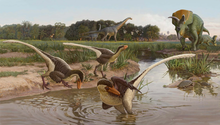Dineobellator
Dineobellator (meaning Diné warrior, pronounced /dɪˌneɪoʊbəˈleɪtər/) is a genus of dromaeosaurid theropod dinosaur that lived in North America during the Late Cretaceous period. The remains have been found in the Maastrichtian stage of the Naashoibito Member at the Ojo Alamo Formation, New Mexico.[1]
The holotype remains were first recovered in 2008 from the Ojo Alamo Formation by Robert M. Sullivan, Steven E. Jasinski and James Nikas. Sullivan and Jasinski collected additional material in 2009. In 2011, the find was reported in the scientific literature.[2] Further excavations were performed by Jasinski in 2015 and 2016.[1]
The remains were realized as belonging to a new taxon, which was only named and described in 2020, by Jasinski, Sullivan and Peter Dodson. It was given the species name Dineobellator notohesperus; the generic name is derived from Diné, the Navajo word used for the people of the Navajo Nation, and bellator, the Latin word for warrior. The specific name is derived from the Greek noto~ (νότος) for southern or south, and hesperis (Ἑσπερίς), meaning western, together "southwest", in reference to the American Southwest.[1]
Dineobellator was around 2.5–3 m (8.2–9.8 ft) in length and is believed to have weighed about 25 to 40 kg (55 to 88 lb).[3] Unique features of the skeleton suggest greater hand and feet flexion than normal for dromaeosaurs, a tighter grip strength in the manual unguals, and greater movement at the tail base. These may aid in agility and predation. Additionally, the presence of quill knobs on the ulna suggest it was feathered, as assumed for all dromaeosaurids.[1]
Phylogenetic analysis places Dineobellator in the Velociraptorinae. Its presence, along with that of Acheroraptor and Dakotaraptor, suggests dromaeosaurs were still diversifying by the end of the Cretaceous. The appearance of a second North American velociraptorine suggests the vicariance of these taxa in North America after a Campanian-Maastrichtian dispersal event. Below is the phylogenetic tree found by the authors:[1]
One of the claws on the right hand of the type specimen of Dineobellator bears a gouge, the size of which is consistent with the claws of a similarly-sized theropod, possibly another Dineobellator. No evidence of healing is present, suggesting that the injury occurred close to the time of death. A broken and re-healed rib was also documented in the specimen.[1]


